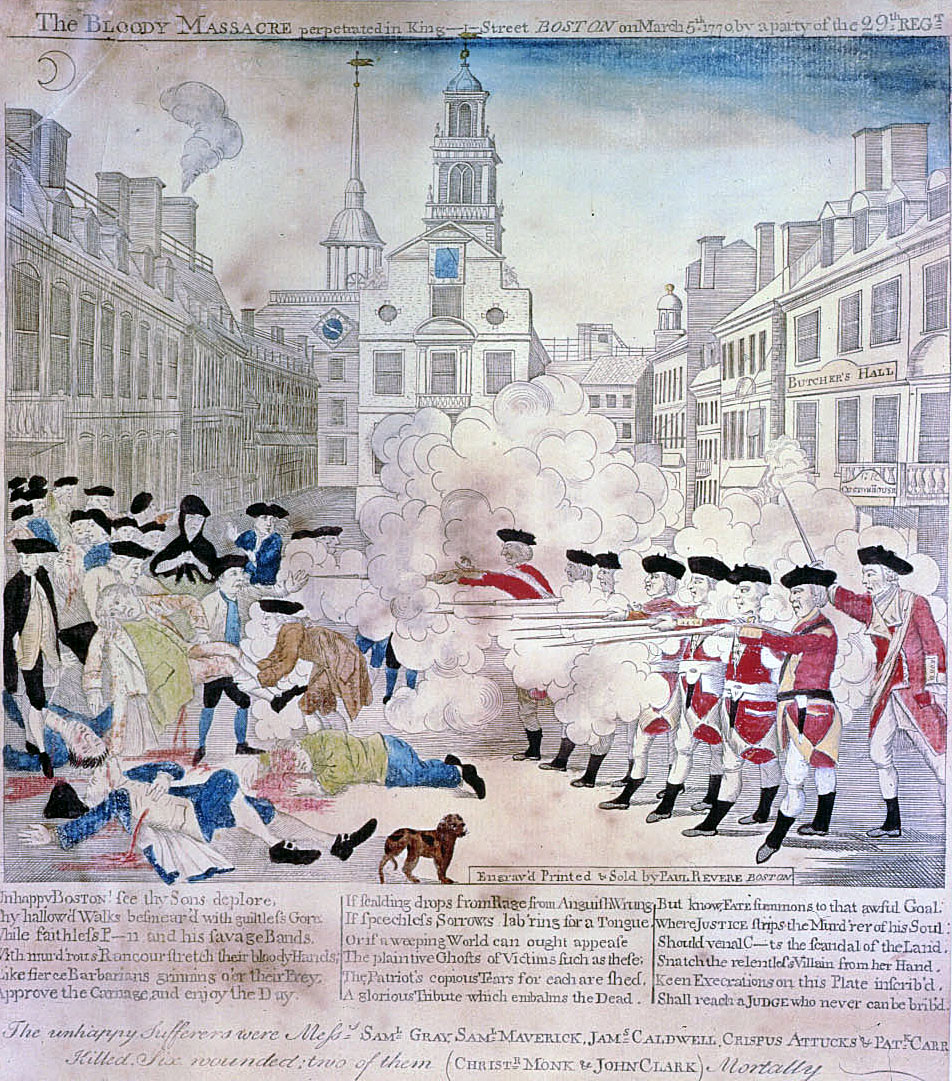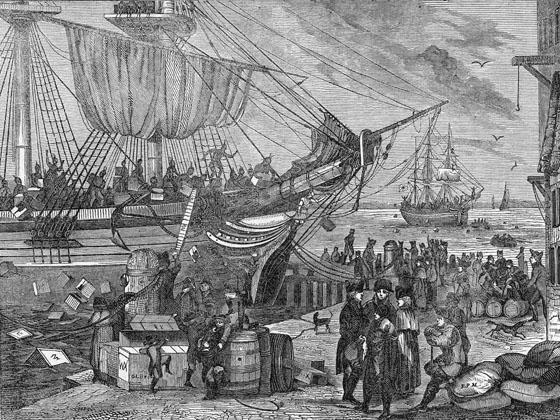Overview
The American Revolution is clearly one of the most significant events in American history. It is the event that both created our nation and the first to define it. Most of the sources contained in this section focus on the actual conflict and many are concerned with defining that conflict in terms that will solicit support, sympathy and/or inspiration.
 At the time of the American Revolution, most Americans considered themselves residence of a particular colony and their political and social consciousness and allegiances stemmed from that political and geographic entity. The concept of a United States was, although first identified and defined in 1776, something that would take years to fully mature in the minds of most citizens. Many historians feel that this national identity did not completely maturate until the end of the Civil War. One of the great challenges facing rebellious American politicians was how to get these various and disparate states to work together for a common cause of first protest and then independence from Britain. Americans focused their attention first to home – which as Englishmen meant England – and then secondly to their own colonies. This consciousness is reflected in the print culture of the time as is evidenced in the broadsides and newspaper accounts included here about the battles of Lexington and Concord. Although printed by local, Massachusetts printers the main audience was not Massachusetts residents who long before these articles were set in type would have known all about these events and have formed deep-set opinions about them. These articles were, instead, designed for the citizens of other colonies who would read them reprinted in their own newspapers. Throughout this time period newspapers were sold primarily by subscription and printers regularly sent their papers to other printers. It was an accepted practice not only to share free subscriptions but for printers to reprint in their own newspapers, often without attribution, stories that appeared in any other source. Often material would appear in multiple formats: as a broadside, in a newspaper and yet again in a pamphlet. This exchange also worked across the Atlantic.
At the time of the American Revolution, most Americans considered themselves residence of a particular colony and their political and social consciousness and allegiances stemmed from that political and geographic entity. The concept of a United States was, although first identified and defined in 1776, something that would take years to fully mature in the minds of most citizens. Many historians feel that this national identity did not completely maturate until the end of the Civil War. One of the great challenges facing rebellious American politicians was how to get these various and disparate states to work together for a common cause of first protest and then independence from Britain. Americans focused their attention first to home – which as Englishmen meant England – and then secondly to their own colonies. This consciousness is reflected in the print culture of the time as is evidenced in the broadsides and newspaper accounts included here about the battles of Lexington and Concord. Although printed by local, Massachusetts printers the main audience was not Massachusetts residents who long before these articles were set in type would have known all about these events and have formed deep-set opinions about them. These articles were, instead, designed for the citizens of other colonies who would read them reprinted in their own newspapers. Throughout this time period newspapers were sold primarily by subscription and printers regularly sent their papers to other printers. It was an accepted practice not only to share free subscriptions but for printers to reprint in their own newspapers, often without attribution, stories that appeared in any other source. Often material would appear in multiple formats: as a broadside, in a newspaper and yet again in a pamphlet. This exchange also worked across the Atlantic.
These early accounts are clearly biased with the American positioning themselves as innocent victims of unprovoked cruelty on the part of the Royal government, or as self-sacrificing heroes and martyrs for the “glorious cause” of American rights and independence. A common theme pronounced in many of these accounts is the righteous and moral behavior of Americans often in contrast to the venal behavior of Royal authorities.
The identification and glorification of heroes and heroines was an important part of this effort to define the newly emerging United States. This process called on both already established heroes such as Israel Putnam, William Prescott, and George Washington, men who had earned respect and distinction for their combat service during the French Indian War as well as the creation of new heroes such as Molly Pitcher and Joseph Warren. Some of these are relatively unknown to us today but were, in their own time, so famous as to be considered celebrities. Warren particularly embodied all the attributes of eighteenth century American manhood he was tall, handsome, intelligent, eloquent, and a self sacrificing physician who turned his back on a lucrative career healing the wealthy to serve the poor. His death at the climax of the first true battle of the war on Breed’s Hill would crown him the first martyr for the American cause and insure his widespread fame for two generations.
At the time of the Revolution itself visual images were created by one of the following ways, painting in either oil or water based paints, woodblocks, and engravings on copper plates. All of these methods required great skill and resulted in images that were expensive and fairly rare. Although there was a nascent graphic arts industry in place in the American colonies, a large percentage of illustrations still came from Britain and Europe.
This section also contains many visual sources that are not strictly primary sources as they were not created at the time of the Revolution itself. Many were created in the early and mid-nineteenth century when the process of lithography made widespread distribution of historic and national scenes not only possible but profitable.
 Lithography is a process for printing based upon the fact that water and oil repel one another. A lithograph is created when special waxy crayons are used to draw on smooth limestone tablets. Water is then applied to the stone where it stays on the areas not covered by the wax drawing. When an oily ink is applied to the stone by roller it adheres only to the drawing and is repelled by the wet stone. The print is then made by pressing paper against the inked drawing. Although first created in 1798, lithography did not make its appearance in the United States until the 1820s. The first color lithograph (chromo lithograph) appeared in 1840.
Lithography is a process for printing based upon the fact that water and oil repel one another. A lithograph is created when special waxy crayons are used to draw on smooth limestone tablets. Water is then applied to the stone where it stays on the areas not covered by the wax drawing. When an oily ink is applied to the stone by roller it adheres only to the drawing and is repelled by the wet stone. The print is then made by pressing paper against the inked drawing. Although first created in 1798, lithography did not make its appearance in the United States until the 1820s. The first color lithograph (chromo lithograph) appeared in 1840.
Lithographs were much easier and cheaper to create than engravings and were soon sold and distributed widely throughout antebellum America. One of the most important producers of lithographic images was the firm of Currier and Ives, who often created historical images for consumption by middle class Americans. Additionally, the creation of the American Art Union in 1840 distributed fine reproductions of paintings depicting American landscapes and historical scenes and further served to develop an indigenous appetite for the visual arts.
The widespread distribution of artistic lithographic prints also coincided with the sectional conflict over slavery. As the nation moved closer to Civil War, Americans may have turned for inspiration and a shared national identity in images from the past. Likewise the image of Washington inspecting the troops was created in 1941, a time when Americans were marshalling their forces for another fight against the Axis powers of World War II.